Many are captivated by the elegance of Victorian gowns, dreaming of the layers, colors, and ribbons that define the era. For those with roots in the American Southwest, like Arizona natives and Daughters of Utah Pioneers, an additional layer of interest emerges: pioneer clothing. This blend of historical fashion curiosity and regional heritage naturally leads to questions about how frontier fashions differed from those in established Eastern cities during the 19th century.
Pioneer women faced unique considerations when building their wardrobes. Practicality, social expectations, and available resources all played a role. This exploration delves into the foundational elements of pioneer women’s attire, uncovering the basics that shaped their style on the Western frontier.
Defining the Frontier Context
For this discussion, “frontier” refers to the regions west of Missouri and Arkansas, spanning roughly from 1850 to 1890. The focus is on the clothing worn by women homesteaders and those in settlement communities, primarily white settlers migrating westward from the East.
It’s important to appreciate that pioneer clothing was less about displaying status and more about the shared experience of pursuing dreams and exploring the unknown. Functionality and community spirit were key elements in frontier fashion.
Essential Underclothes
Surprisingly, the foundational undergarments worn by women on the frontier were quite similar to those in Eastern cities. The chemise, a light cotton slip, was a crucial base layer for hygiene and frequent washing. Pantalets, made from flannel or cotton, were added for modesty, serving a purpose akin to early underpants.
Despite assumptions about frontier informality, corsets were a common undergarment for pioneer women. Many women journeying west were driven by aspirations for a better future, whether economic or religious. They were “proper” women who valued societal norms and likely wouldn’t abandon such a fundamental garment of the time.
While corsets might have been loosened or forgone during strenuous housework, most frontier women brought corsets and wore them whenever feasible.
Petticoats, offering volume and shape to skirts, were another staple. Like dresses, women often had multiple petticoats for varying levels of formality or weather conditions. Stockings were essential for venturing outside or receiving guests, typically secured with garters or tucked into pantalets. The latter method might seem uncomfortable, but practicality often outweighed comfort in frontier life.
Fabrics of Choice for Pioneer Outfits
Calico was the dominant fabric for pioneer clothing. Often envisioned as quaint floral prints, calico is actually a type of plain-woven cotton, slightly lighter than canvas. Its lightweight yet sturdy nature, combined with ease of cleaning, made it ideal for the demands of outdoor frontier life. General stores offered dyed calico, but women also dyed fabric themselves using store-bought options or natural dyes derived from plants like leaves, bark, berries, and fruits.
Cotton and silk remained fabrics for “Sunday best” and more formal dresses, and many women brought such garments westward.
Fabrics were generally available at general stores, although accessibility varied depending on location and proximity to settlements. In more isolated areas, families often had to produce their own fabrics, a complex skill in itself, but that’s a topic for another discussion.
Daily Wear for Pioneer Women
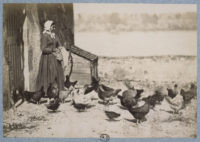 Pioneer woman in a simple dress and apron
Pioneer woman in a simple dress and apron
Regardless of their backgrounds, women in frontier settlements were essential contributors to establishing and maintaining homes and farms. Their days were filled with cooking, cleaning, childcare, laundry, and often fieldwork. Family success relied on everyone’s physical labor, with no room for outsourcing domestic tasks. Frontier women quickly adapted to a life of demanding manual work.
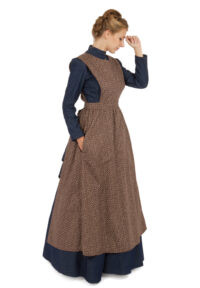 Calico apron typical of pioneer attire
Calico apron typical of pioneer attire
Pioneer Calico Apron
General dress styles of the era, featuring fitted bodices and full skirts, were adapted for pioneer life. Skirts for everyday wear were hemmed about three inches shorter for easier movement during chores. Some might have even had weights sewn into the hems to prevent skirts from blowing up in windy conditions, maintaining modesty.
Bodices remained fitted, but sleeves were looser, extending to the wrists, and paired with high collars to protect against the sun’s harsh rays.
Laundering pioneer clothing was a significant task. “Wash dresses” emerged as a practical solution. As mentioned in Chris Enss’s book, How the West Was Worn, a popular “wash dress” of white cotton with a printed pattern appeared around 1867. Its easy care made it widely adopted across socioeconomic levels and by seamstresses throughout the West. While further research is needed to fully understand the “wash dress,” it exemplifies how fashion adapted to the practical needs of frontier families.
Sunday Best: Pioneer Style for Church
 Pioneer couple dressed for church or a social event
Pioneer couple dressed for church or a social event
Even in sparsely populated areas, settlements often had churches, and community members generally attended services. While accounts exist of women in impoverished communities arriving barefoot, it was more common for women to have dedicated “Sunday best” dresses. However, historical records often lean towards documenting more privileged settlers, making it difficult to definitively know the most typical experience.
“Sunday best” attire on the frontier mirrored fashionable city styles. Full skirts, petticoats, and corsets were standard. Sleeve styles of the time, like bell, leg-o-mutton, or pagoda sleeves, were incorporated. Skirt styles also followed trends, with crinoline, hoop, or bustle silhouettes appearing depending on the decade.
Color choices reflected age and marital status. Younger and newly married women favored lighter colors, transitioning to darker shades within a few years. Sunday outfits were completed with fashionable hats, kid gloves, and low-heeled boots.
Dressing for Socializing on the Frontier
For those with the means, wardrobes extended beyond daily and Sunday dresses to include outfits specifically for socializing. Dances, holiday celebrations, picnics, and other community gatherings were common, and women, as in Eastern cities, dressed for these occasions.
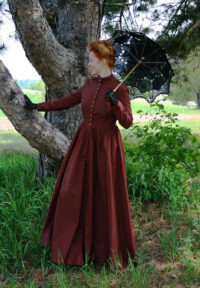 Woman in a refined dress suitable for church or social events
Woman in a refined dress suitable for church or social events
Mary Chestnut’s Americana Victorian Cotton Dress
These social dresses were highly valued. Women might order fabrics from general stores and eagerly await the chance to create fashionable pieces. Godey’s Lady’s Book was a significant influence, circulated among frontier women who enthusiastically copied dress patterns and styles from its pages.
Fabric availability for new dresses depended heavily on the proximity and accessibility of general stores. In many cases, women had a limited number of dresses, using their best garments for special events and enhancing them with embellishments. Accessories like hand-crocheted collars and shawls were popular for elevating an outfit.
Accessories: The Finishing Touches of Pioneer Outfits
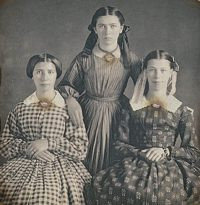 Frontier girls with bonnets and aprons
Frontier girls with bonnets and aprons
Accessories were not afterthoughts but integral to pioneer women’s wardrobes. Beyond just hoop skirts and calico, the finishing touches were significant. Jewelry and accessories held such importance that they warrant a dedicated discussion in a future post.
Pioneer women accessorized their outfits with:
- Aprons
- Boots
- Brooches
- Lockets
- Earrings
- Precious stones and metals
- Hair adornments
- Hats
- Collars and cuffs
- Gloves
- Undersleeves
- Parasols
- Fans
- Handbags
- Shawls
A Surviving Legacy of Pioneer Style
Exploring pioneer clothing reveals the resourcefulness and adaptability of women on the frontier. While “prairie style,” “pioneer,” and “western wear” clothing are readily available today, understanding the historical context reveals how pioneer women balanced propriety, beauty, and fashion with the demands of a physically challenging life.
This exploration is just the beginning. Future discussions will delve deeper into specific aspects of pioneer fashion, including accessories. Stay tuned for a follow-up post on accessories in frontier fashion.
Create Your Own Pioneer Look:
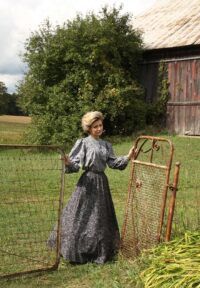 Woman modeling a pioneer-style blouse and skirt
Woman modeling a pioneer-style blouse and skirt
Pioneer Calico Blouse and Skirt
Browse our entire pioneer clothing collection
Pioneer Calico Blouse and Skirt
Harper Victorian Pioneer Dress
Pioneer Blouse, Apron and Skirt
